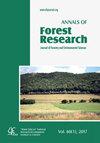New regional records of Dothistroma needle blight pathogens from Slovakia: distribution, hosts and pathogens characterization
IF 2.9
3区 农林科学
Q2 FORESTRY
引用次数: 1
Abstract
Dothistroma needle blight is one of the most severe needle diseases of pines caused by two closely related species, Dothistroma septosporum and D. pini. The further spread and distribution of this disease were investigated in Slovakia, and new hosts and stand types were identified at the regional level. Dothistroma septosporum was recorded in a natural stand at higher altitude on Pinus cembra in the High Tatras and the P. uncinata records are new host reports for Slovakia for this pathogen. Moreover, for D. pini, P. cembra as a new host at the country level was recorded and P. armandii was identified as new host species worldwide. Mating types for all collected samples and ITS haplotypes for D. pini isolates were determined. For D. pini, five localities with the presence of both mating types and three ITS haplotypes (Dp_HAP.1, Dp_HAP.2 and Dp_ HAP.4) were reported. Samples where both mating types of the pathogens were identified, were selected for the microscopic examination of fruiting bodies aimed to detect sexual reproductive organs. In all inspected needle samples of D. pini, only conidiomata with typical hyaline cylindrical conidia were identified. The sexual state of D. septosporum was recorded in one sample of P. nigra needles.斯洛伐克针叶枯病病原菌的新区域记录:分布、寄主和病原菌特征
针叶枯病是由两种亲缘关系密切的针叶枯病(Dothistroma septosporum)和针叶枯病(D. pini)引起的最严重的松树针叶病害之一。在斯洛伐克调查了这种疾病的进一步传播和分布,并在区域一级确定了新的宿主和林分类型。septosporum是在高塔特拉山的一处高海拔天然林分上记录到的,而P. uncinata是斯洛伐克新报道的病原菌寄主。此外,pini在国家一级记录了P. cembra为新寄主,在世界范围内确定了P. armandii为新寄主。测定了所有样品的交配型和分离株的ITS单倍型。pini的5个位点同时存在交配型和3个ITS单倍型(Dp_HAP)。1, Dp_HAP。2和Dp_ HAP.4)。在确定了两种交配类型的病原体的样品中,选择用于子实体的显微镜检查,目的是检测性生殖器官。在所有检查的针样中,仅鉴定出具有典型的透明圆柱形分生孢子。在一份黑檀针叶中记录了间隔孢子菌的性态。
本文章由计算机程序翻译,如有差异,请以英文原文为准。
求助全文
约1分钟内获得全文
求助全文
来源期刊

Annals of Forest Research
FORESTRY-
CiteScore
2.20
自引率
11.10%
发文量
11
审稿时长
12 weeks
期刊介绍:
Annals of Forest Research is a semestrial open access journal, which publishes research articles, research notes and critical review papers, exclusively in English, on topics dealing with forestry and environmental sciences. The journal promotes high scientific level articles, by following international editorial conventions and by applying a peer-review selection process.
 求助内容:
求助内容: 应助结果提醒方式:
应助结果提醒方式:


